2020慕尼黑华南电子展+electronica South China及组团参观信息
- 格式:doc
- 大小:30.00 KB
- 文档页数:2
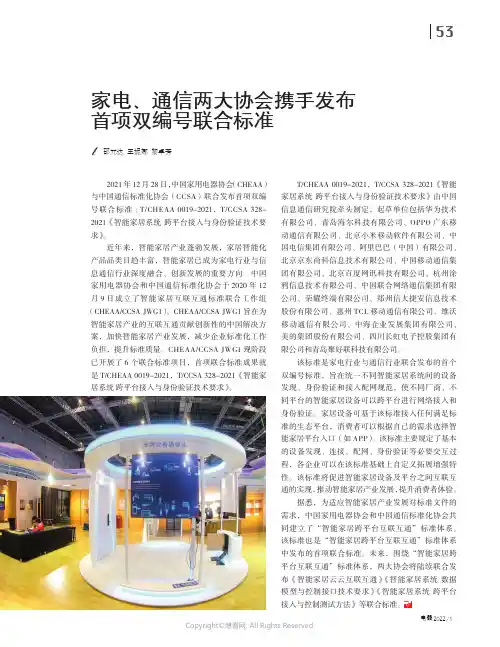
532021年12月28日,中国家用电器协会(CHEAA)与中国通信标准化协会(CCSA)联合发布首项双编号联合标准:T/CHEAA 0019-2021,T/CCSA 328-2021《智能家居系统 跨平台接入与身份验证技术要求》。
近年来,智能家居产业蓬勃发展,家居智能化产品品类日趋丰富,智能家居已成为家电行业与信息通信行业深度融合、创新发展的重要方向。
中国家用电器协会和中国通信标准化协会于2020年12月9日成立了智能家居互联互通标准联合工作组(CHEAA/CCSA JWG1)。
CHEAA/CCSA JWG1旨在为智能家居产业的互联互通贡献创新性的中国解决方案,加快智能家居产业发展,减少企业标准化工作负担,提升标准质量。
CHEAA/CCSA JWG1现阶段已开展了6个联合标准项目,首项联合标准成果就是T/CHEAA 0019-2021,T/CCSA 328-2021《智能家居系统 跨平台接入与身份验证技术要求》。
邵光达 王妮娜 黎卓芳家电、通信两大协会携手发布首项双编号联合标准T/CHEAA 0019-2021,T/CCSA 328-2021《智能家居系统 跨平台接入与身份验证技术要求》由中国信息通信研究院牵头制定,起草单位包括华为技术有限公司、青岛海尔科技有限公司、OPPO 广东移动通信有限公司、北京小米移动软件有限公司、中国电信集团有限公司、阿里巴巴(中国)有限公司、北京京东尚科信息技术有限公司、中国移动通信集团有限公司、北京百度网讯科技有限公司、杭州涂鸦信息技术有限公司、中国联合网络通信集团有限公司、荣耀终端有限公司、郑州信大捷安信息技术股份有限公司、惠州TCL 移动通信有限公司、维沃移动通信有限公司、中海企业发展集团有限公司、美的集团股份有限公司、四川长虹电子控股集团有限公司和青岛聚好联科技有限公司。
该标准是家电行业与通信行业联合发布的首个双编号标准,旨在统一不同智能家居系统间的设备发现、身份验证和接入配网规范,使不同厂商、不同平台的智能家居设备可以跨平台进行网络接入和身份验证。
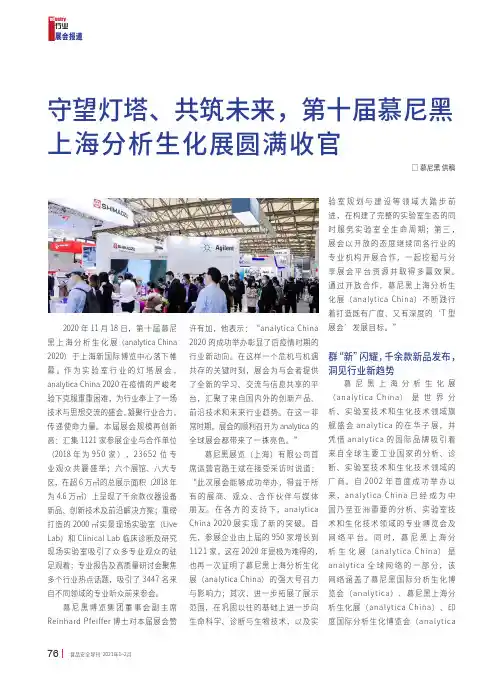
Iustry展会报道行业76 食品安全导刊 2021年1~2月2020年11月18日,第十届慕尼黑上海分析生化展(analytica China 2020)于上海新国际博览中心落下帷幕。
作为实验室行业的灯塔展会,analytica China 2020在疫情的严峻考验下克服重重困难,为行业奉上了一场技术与思想交流的盛会,凝聚行业合力,传递使命力量。
本届展会规模再创新高:汇集1121家参展企业与合作单位(2018年为950家),23652位专业观众共襄盛举;六个展馆、八大专区,在超6万㎡的总展示面积(2018年为4.6万㎡)上呈现了千余款仪器设备新品、创新技术及前沿解决方案;重磅打造的2000㎡实景现场实验室(LiveLab)和Clinical Lab 临床诊断及研究现场实验室吸引了众多专业观众的驻足观看;专业报告及高质量研讨会聚焦多个行业热点话题,吸引了3447名来自不同领域的专业听众前来参会。
慕尼黑博览集团董事会副主席Reinhard Pfeiffer 博士对本届展会赞许有加,他表示:“analytica China 2020的成功举办彰显了后疫情时期的行业新动向。
在这样一个危机与机遇共存的关键时刻,展会为与会者提供了全新的学习、交流与信息共享的平台,汇聚了来自国内外的创新产品、前沿技术和未来行业趋势。
在这一非常时期,展会的顺利召开为analytica 的全球展会都带来了一抹亮色。
”慕尼黑展览(上海)有限公司首席运营官路王斌在接受采访时说道:“此次展会能够成功举办,得益于所有的展商、观众、合作伙伴与媒体朋友。
在各方的支持下,analytica China 2020展实现了新的突破。
首先,参展企业由上届的950家增长到1121家,这在2020年是极为难得的,也再一次证明了慕尼黑上海分析生化展(analytica China)的强大号召力与影响力;其次,进一步拓展了展示范围,在巩固以往的基础上进一步向生命科学、诊断与生物技术,以及实验室规划与建设等领域大踏步前进,在构建了完整的实验室生态的同时服务实验室全生命周期;第三,展会以开放的态度继续同各行业的专业机构开展合作,一起挖掘与分享展会平台资源并取得多赢效果。
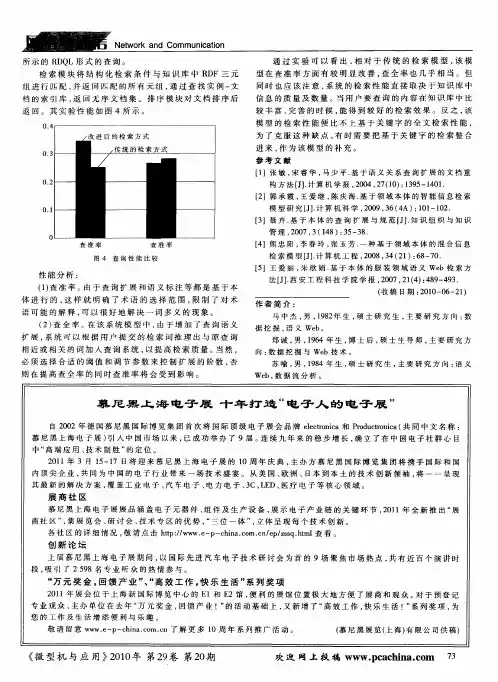
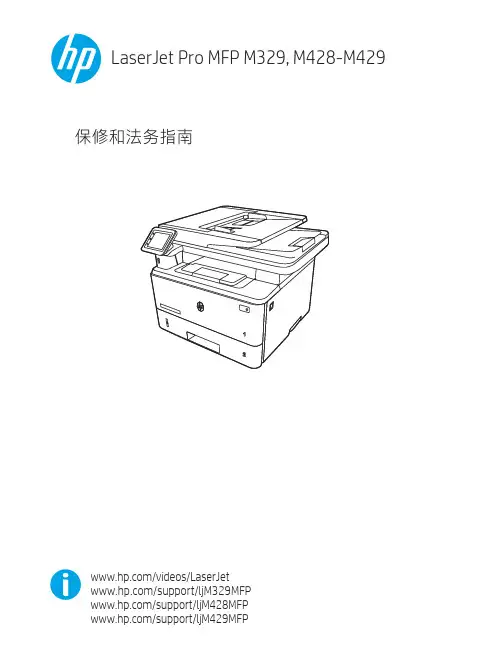
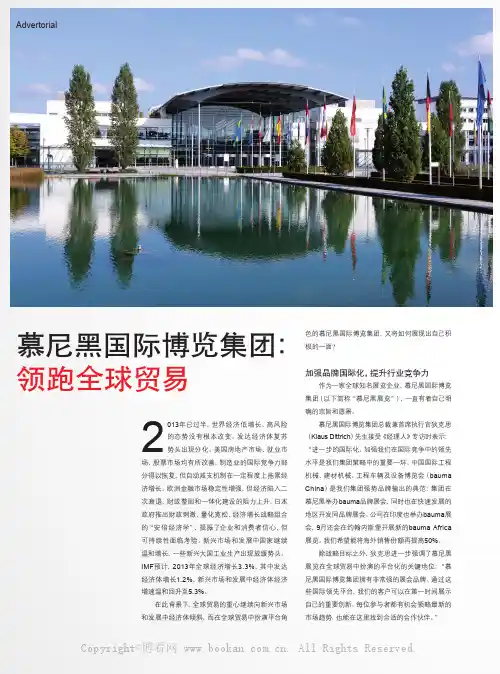
Advertorial慕尼黑国际博览集团:领跑全球贸易2013年已过半,世界经济低增长、高风险的态势没有根本改变。
发达经济体复苏势头出现分化。
美国房地产市场、就业市场、股票市场均有所改善,制造业的国际竞争力部分得以恢复,但自动减支机制在一定程度上拖累经济增长。
欧洲金融市场稳定性增强,但经济陷入二次衰退,财政整固和一体化建设的阻力上升。
日本政府推出财政刺激、量化宽松、经济增长战略组合的“安倍经济学”,提振了企业和消费者信心,但可持续性面临考验。
新兴市场和发展中国家继续温和增长,一些新兴大国工业生产出现放缓势头。
IMF预计,2013年全球经济增长3.3%,其中发达经济体增长1.2%,新兴市场和发展中经济体经济增速温和回升至5.3%。
在此背景下,全球贸易的重心继续向新兴市场和发展中经济体倾斜,而在全球贸易中扮演平台角色的慕尼黑国际博览集团,又将如何展现出自己积极的一面?加强品牌国际化,提升行业竞争力作为一家全球知名展览企业,慕尼黑国际博览集团(以下简称“慕尼黑展览”),一直有着自己明确的宗旨和愿景。
慕尼黑国际博览集团总裁兼首席执行官狄克思(Klaus Dittrich)先生接受《经理人》专访时表示:“进一步的国际化、加强我们在国际竞争中的领先水平是我们集团策略中的重要一环。
中国国际工程机械、建材机械、工程车辆及设备博览会(bauma China)是我们集团强势品牌输出的典范:集团在慕尼黑举办bauma品牌展会,同时也在快速发展的地区开发同品牌展会。
公司在印度也举办bauma展会,9月还会在约翰内斯堡开展新的bauma Africa 展览。
我们希望能将海外销售份额再提高50%。
除战略目标之外,狄克思进一步强调了慕尼黑展览在全球贸易中扮演的平台化的关键地位:“慕尼黑国际博览集团拥有非常强的展会品牌。
通过这些国际领先平台,我们的客户可以在第一时间展示自己的重要创新。
每位参与者都有机会领略最新的市场趋势,也能在这里找到合适的合作伙伴。
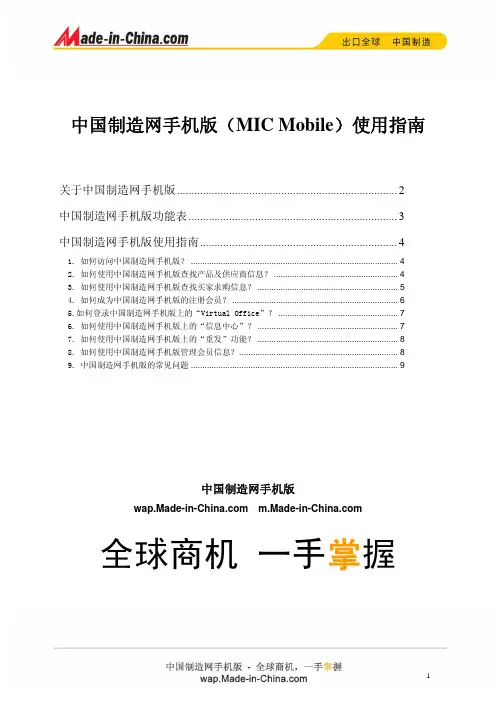
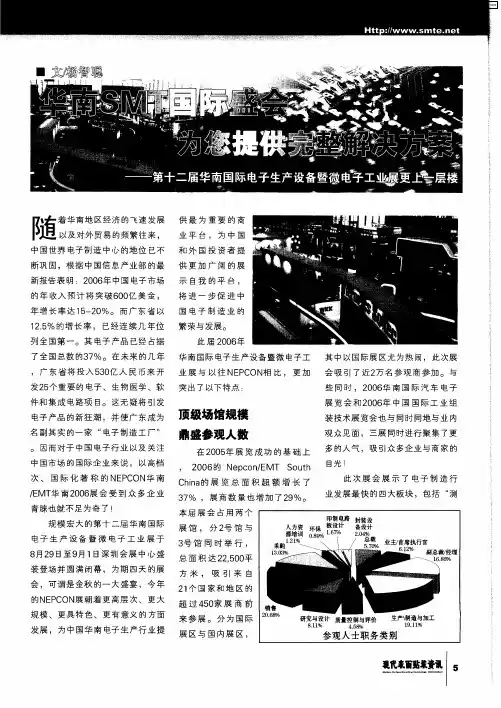
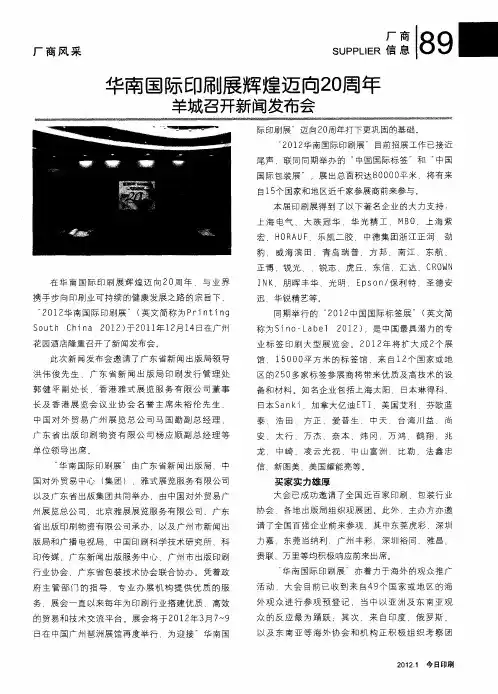
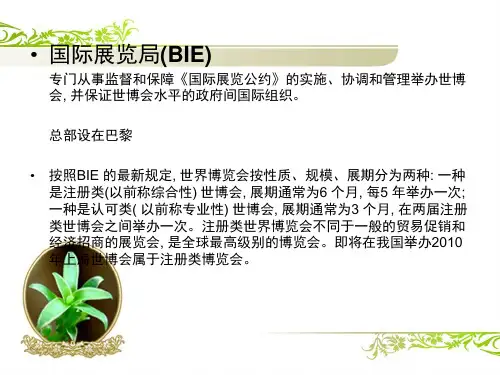
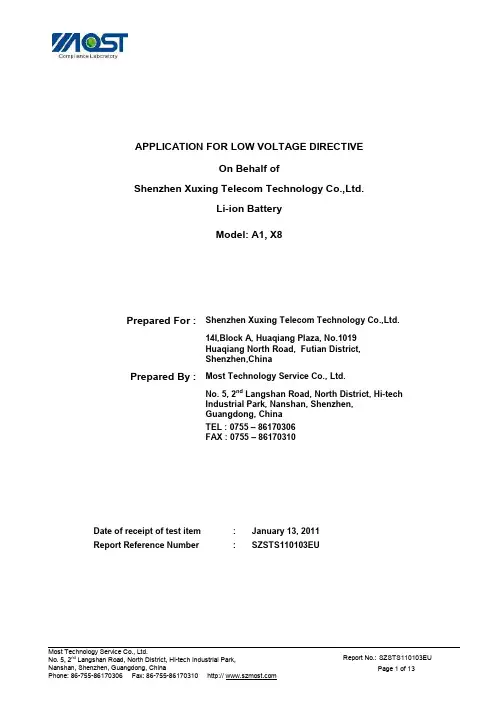
APPLICATION FOR LOW VOLTAGE DIRECTIVEOn Behalf ofShenzhen Xuxing Telecom Technology Co.,Ltd.Li-ion BatteryModel: A1, X8Prepared For : Shenzhen Xuxing Telecom Technology Co.,Ltd.14I,Block A, Huaqiang Plaza, No.1019Huaqiang North Road, Futian District,Shenzhen,ChinaPrepared By : Most Technology Service Co., Ltd.No. 5, 2nd Langshan Road, North District, Hi-techIndustrial Park, Nanshan, Shenzhen,Guangdong, ChinaTEL : 0755 – 86170306FAX : 0755 – 86170310Date of receipt of test item : January 13, 2011Report Reference Number : SZSTS110103EU______ST/SG/AC.10/11Rev.5 Section 38.3Clause Requirement- Test Result - Remark Verdict38.3 Lithium metal and lithium ion batteries P 38.3.1 Purpose PThis section presents the procedures to be followedfor the classification of Lithium metal and lithium ioncells and batteries.P 38.3.2 Scope P 38.3.2.1 Lithium metal and lithium ion cells and batteries whichdiffer from a tested type by:Pa) For primary cells and batteries, a change of morethan 0.1 g or 20% by mass, whichever is greater, tothe cathode, to the anode, or to the electrolyte.Nb) For rechargeable cells and batteries, a change inwatt-hours of more than 20% or an increase in voltageof more than 20%.Pc) A change that would materially affect the testresults. Shall be considered a new type and shall besubjected to the required test.P38.3.2.2 I For the purposes of classification, the followingdefinitions apply:P38.3.3 When a cell or battery type is to be tested underthis sub-section, the number and condition ofcells and batteries of each type to be tested are asfollows: Tests 1 to 5 must beconducted in sequence onthe same battery,Pa) When testing primary cells and batteries undertests 1 to 5, the following shall be tested:N Ten cells in undischarged states, N Ten cells in fully discharged states, N Four small batteries in undischarged states, N Four small batteries in fully discharged states, N Four large batteries in undischarged states N Four large batteries in fully discharged states N b) when testing rechargeable cells and batteries undertests 1 to 5 the following shall be tested:P Ten cells at first cycle, in fully charged states, N Four small batteries at first cycle, in fully chargedstates.P Four small batteries 50 cycle ending in fully chargedstates.P Two large batteries at first cycle, in fully chargedstates. N Two large batteries 25 cycle ending in fully chargedstates.NClause Requirement- TestResult - RemarkVerdict______c) When testing primary and rechargeable cells under test 6(Impact), the following shall be tested in the quantity indicated:PFor primary cells, five cells in undischarged states and five cells in fully discharged statesPFor component cells of primary batteries, Five cells in undischarged states and five cells in fully discharged states.NFor rechargeable cells, five cells at first cycle at 50% of the design rated capacity,N For components cells of rechargeable batteries, five cells at first cycle at 50% of the design rated capacity.PFor prismatic cells, ten test cells are required instead of the five described above, so that the procedure can be carried out on five cells along the longitudinal axes and, separately, five cells along the other axes. In every case, the test cell is only subjected to one impacPd) When testing rechargeable batteries under test 7(Overcharge), the following shall be tested in the quantity indicated:PFour small batteries at first cycle, in fully charged states.P Four small batteries after 50 cycles ending in fully charged states.P Two large batteries at first cycle, in fully charged states,N Two large batteries after 25 cycles ending in fully charged states.Ne) When testing primary and rechargeable cells under test 8(Forced Discharge), the following shall be tested in the quantity indicated:The requirement is not applicable to test batteries. N Ten primary cells in fully discharged states N Ten rechargeable cells, at first cycle in fully discharged statesN Ten rechargeable cells after 50 cycles ending in fullydischarged statesNf) when testing a battery assembly in which the aggregate lithium content of all anodes, when fully charged, is not more than 500g, or in the case of a lithium ion battery, with a watt-hour rating of not more than 6200 Watt-hoursNClause Requirement- Test Result - Remark Verdict______38.3.4 ProcedurePTest 1 to 5 must be conducted in sequence on the same cell or battery.P Test 6 and 8 should be conducted using not otherwisetested cells or batteriesPTest 7 may be conducted using undamaged batteriespreviously used in tests 1 to 5 for purposes of testing on cycled batteriesP38.3.4.1 Test 1: Altitude Simulation P 38.3.4.1.1 Purpose P This test simulates air transport under low-pressureconditions.-- 38.3.4.1.2 Test procedureP stored at a pressure 11.6 kPa -- ambient temperature (20 ± 5).℃ 24℃ -- Stored times( ≥ 6 hours) 8 hours. -- 38.3.4.1.3 RequirementCells and batteries meet this requirement if there is nomass loss, no leakage, no venting, no disassembly, no rupture and no fire and if the open circuit voltage of each test cell or battery after testing is not less than 90% of its voltage immediately prior to this procedure. The requirement relating to voltage is not applicable to test cells and batteries at fully discharged statesNo mass loss, no leakage, no venting, no disassembly, no rupture and no fire. Battery after testing is not less than 90% of its voltageimmediately prior to this procedure.PMass M of Test Battery (g)OCV (V) Group No.M1 (beforet he test) M2 (after the test)MassLoss limit(0.1%)OCV1 (beforethe test) OCV2 (after the test) OCV (≥90%)01 21.223g 21.223g0.00%3.861 3.861 100.0% 02 21.178g 21.178g 0.00%3.867 3.867 100.0%03 21.338g 21.338g 0.00%3.866 3.866 100.0% Group A (at first cycle, infully charged states) 04 21.385g 21.385g 0.00% 3.862 3.862 100.0% 05 21.142g 21.142g 0.00%3.865 3.865 100.0% 06 21.465g 21.465g 0.00%3.854 3.854 100.0% 07 21.276g 21.276g 0.00%3.860 3.860 100.0% Group B (after fiftycycles ending in fullycharged states)08 21.328g 21.328g 0.00%3.8673.867100.0%Remark1.Mass loss (%)=(M1-M2)/M1*100% (Where M 1 is the mass before the test and M 2 is the mass after the test)2.When mass loss does not exceed the value in Table: Mass loss limit, it shall be considered as "no mass loss".3.The OCV of each test cell after testing is not less than 90% of its voltage immediately prior to this procedure.4. Ambient temperature: 24℃Conclusion:Clause Requirement- TestResult - RemarkVerdict______Li-ion Battery had passed altitude simulation test.38.3.4.2 Test 2: Thermal Test P 38.3.4.2.1 Purpose P This test assesses cell and battery seal integrity andinternal electrical connections. The test is conducted using rapid and extreme temperature changes.P38.3.4.2.2 Test procedurePTest temperature and stored hours 1) 75℃, ≥6h 2) -40℃, ≥6h-- The maximum time intervalBetween test temperature extremes is 30 minutes. --Test timesrepeated 10 times -- After which all test cells and batteries are to be storedfor 24 hours at ambient temperature (20±5℃)24℃ -- For large cells and batteries the duration of exposure tothe test temperature extremes should be at least 12 hours.Small batteryN 38.3.4.2.3 RequirementCells and batteries meet this requirement if there is nomass loss, no leakage, no venting, no disassembly, no rupture and no fire and if the open circuit voltage of each test cell or battery after testing is not less than 90% of its voltage immediately prior to this procedure. The requirement relating to voltage is not applicable to test cells and batteries at fully discharged statesNo mass loss, no leakage, no venting, no disassembly, no rupture and no fire. Battery after testing is not less than 90% of its voltageimmediately prior to this procedure.PMass M of Test Battery (g)OCV (V) Group No. M1 (beforet he test) M2(afterthe test)MassLosslimit(0.1%)OCV1 (beforethe test) OCV2 (after the test) OCV (≥90%) 01 21.223g 21.223g 0.00%3.861 3.835 99.33%02 21.178g 21.178g 0.00%3.867 3.854 99.66% 03 21.338g 21.338g 0.00% 3.866 3.845 99.46% Group A (at first cycle, in fully charged states)04 21.385g 21.385g 0.00% 3.862 3.836 99.33% 05 21.142g 21.142g 0.00%3.865 3.842 99.40% 06 21.465g 21.465g 0.00%3.854 3.836 99.53% 07 21.276g 21.276g 0.00%3.860 3.837 99.40% Group B (after fiftycycles ending in fullycharged states)08 21.328g 21.328g 0.00%3.8673.85399.64%Remark1.Mass loss (%)=(M1-M2)/M1*100% (Where M 1 is the mass before the test and M 2 is the mass after the test)2.When mass loss does not exceed the value in Table: Mass loss limit, it shall be considered as "no mass loss".3.The OCV of each test cell after testing is not less than 90% of its voltage immediately prior to this procedure.4. Ambient temperature: 24℃Conclusion:Clause Requirement- TestResult - RemarkVerdict______Li-ion Battery had passed thermal test.38.3.4.3 Test 3: Vibration P 38.3.4.3.1 PurposePThis test simulates vibration during transport..P 38.3.4.3.2 Test procedure PCells and batteries are firmly secured to the platform of the vibration machine without distorting the cells insuch a manner as to faithfully transmit the vibration.-- The vibration shall be a sinusoidal waveform with a logarithmicP Duration 15min -- Frequency range 7Hz... ..200Hz.....7Hz -- Amplitude 0.8mm -- This cycle shall be repeated 12 times for a total of 3 hours for each of three mutually perpendicular mounting positions of the cell.-- 38.3.4.3.3 Requirement PCells and batteries meet this requirement if there is no mass loss, no leakage, no venting, no disassembly, no rupture and no fire and if the open circuit voltage of each test cell or battery after testing is not less than 90% of its voltage immediately prior to this procedure. The requirement relating to voltage is not applicable to test cells and batteries at fully discharged states No mass loss, no leakage,no venting, no disassembly, no rupture and no fire. PMass M of Test Battery (g) OCV (V)GroupNo. M1 (beforet he test) M2(afterthe test)MassLosslimit(0.1%)OCV1 (beforethe test) OCV2 (after the test) OCV (≥90%) 01 21.223g 21.223g 0.00% 3.835 3.835 100.0% 02 21.178g 21.178g 0.00% 3.854 3.854 100.0% 03 21.338g 21.338g 0.00% 3.845 3.845 100.0% Group A (at first cycle, in fully charged states) 04 21.385g 21.385g 0.00% 3.836 3.836 100.0% 05 21.142g 21.142g 0.00% 3.842 3.842 100.0% 06 21.465g 21.465g 0.00% 3.836 3.836 100.0% 07 21.276g 21.276g 0.00% 3.837 3.837 100.0% Group B (after fifty cycles ending in fully charged states)08 21.328g 21.328g 0.00%3.8533.853100.0%Remark1.Mass loss (%)=(M1-M2)/M1*100% (Where M 1 is the mass before the test and M 2 is the mass after the test)2.When mass loss does not exceed the value in Table: Mass loss limit, it shall be considered as "no mass loss".3.The OCV of each test cell after testing is not less than 90% of its voltage immediately prior to this procedure.4. Ambient temperature: 24℃Conclusion:Li-ion Battery had passed vibration test.Clause Requirement- TestResult - RemarkVerdict______38.3.4.4 Test 4: Shock P 38.3.4.4.1 PurposePThis test simulates vibration during transport..P 38.3.4.4.2 Test procedurePTest cells and batteries shall be secured to the testing machine by means of a rigid mount which will support all mounting surfaces of each test battery.This is small batteries. -- a half-sine shock of peak acceleration 150 g P Pulse duration 6ms -- the positive direction followed three times shocks --Each cell or battery shall be subjected to three shocks in the positive direction followed by three shocks in the negative direction of three mutually perpendicular mounting positions of the cell or battery for a total of18 shocks.--38.3.4.4.3 Requirement PCells and batteries meet this requirement if there is no mass loss, no leakage, no venting, no disassembly, no rupture and no fire and if the open circuit voltage of each test cell or battery after testing is not less than 90% of its voltage immediately prior to this procedure. The requirement relating to voltage is not applicable to test cells and batteries at fully discharged states No mass loss, no leakage,no venting, no disassembly, no rupture and no fire. PMass M of Test Battery (g) OCV (V)GroupNo. M1 (beforet he test) M2(afterthe test)MassLosslimit(0.1%)OCV1 (beforethe test) OCV2 (after the test) OCV (≥90%) 01 21.223g 21.223g 0.00% 3.835 3.835 100.0% 02 21.178g 21.178g 0.00% 3.854 3.854 100.0% 03 21.338g 21.338g 0.00% 3.845 3.845 100.0% Group A (at first cycle, in fully charged states) 04 21.385g 21.385g 0.00% 3.836 3.836 100.0% 05 21.142g 21.142g 0.00% 3.842 3.842 100.0% 06 21.465g 21.465g 0.00% 3.836 3.836 100.0% 07 21.276g 21.276g 0.00% 3.837 3.837 100.0% Group B (after fifty cycles ending in fully charged states)08 21.328g 21.328g 0.00%3.8533.853100.0%Remark1.Mass loss (%)=(M1-M2)/M1*100% (Where M 1 is the mass before the test and M 2 is the mass after the test)2.When mass loss does not exceed the value in Table: Mass loss limit, it shall be considered as "no mass loss".3.The OCV of each test cell after testing is not less than 90% of its voltage immediately prior to this procedure.4. Ambient temperature: 24℃Conclusion:Li-ion Battery had passed shock test.Clause Requirement- TestResult - RemarkVerdict______38.3.4.5 Test 5: External Short Circuit P 38.3.4.5.1 PurposePThis test simulates an external short circuit. P 38.3.4.5.2 Test procedurePThe cell or battery to be tested shall be temperature stabilized so that its external case temperature reaches 55℃--Short circuit condition with a total External resistance of less than 0.1ohm--The cell or battery must be observed for a further six hours for the test to be concluded.--This short circuit condition is continued for at least one hour after the cell or battery external case temperature has returned to 55℃-- 38.3.4.5.3 RequirementPCells and batteries meet this requirement if theirexternal temperature does not exceed 170℃ and there is no disassembly, no rupture and no fire within six hours of this test. Battery externaltemperature does notexceed 170℃, and there is no disassembly, no fire and no rupture within six hours of this testPGroupNo.External Highest Temperature(℃)Criteria Result0155.6℃ P 02 55.5℃ P 03 55.7℃ P Group A (at first cycle, in fully charged states)04 55.9℃ P 05 55.6℃ P 06 55.7℃ P 07 55.8℃ P Group B (after fifty cycles ending in fully charged states) 0855.9℃Battery external temperature does not exceed 170℃, and there is no disassembly, no fire and no rupture within six hours of this testPAmbient temperature: 23℃Conclusion:Li-ion Battery had passed external short circuit test.Clause Requirement- TestResult - RemarkVerdict______38.3.4.6 Test 6: ImpactThe test sample Component cell of chargeable batteries. P 38.3.4.6.1 PurposePThis test simulates an impact. P 38.3.4.6.2 Test procedureP - Dropped height 61±2.5cm, -- - mass9.1Kg -- - diameter bar 15.8mm --- Impact position:Prismatic cell is to be impacted with its longitudinal axis parallel to the flat surface and perpendicular to the longitudinal axis of the 15.8 mm diameter curved surface lying across the centre of the test sample, Prismatic cell is also to be rotated 90 degrees around its longitudinal axis so that both the wide and narrow sides will be subjected to the impact.--A coin or button cell is to be impacted with the flat surface of the sample parallel to the flat surface and the 15.8 mm diameter curved surface lying across its centre.38.3.4.6.3 RequirementPCells and batteries meet this requirement if theirexternal temperature does not exceed 170℃ andthere is no disassembly, no rupture and no fire within six hours of this test.Battery external temperature does not exceed 170℃, and there isno disassembly, no fire and no rupture within six hours of this testPGroup No. ExternalHighestTemperature(℃)Criteria Result0178.2℃ P 02 76.3℃ P 03 79.4℃ P 04 80.6℃ P Group A (at first cycle, in fully charged states)05 78.5℃ P 0648.3℃ P 07 47.6℃ P 08 50.3℃ P 09 48.6℃ P Group B (after fifty cycles ending in fullycharged states) 1047.9℃Battery external temperature does not exceed 170℃, and there is no disassembly, no fire and no rupture within six hours of this testPAmbient temperature: 23℃Clause Requirement- TestResult - RemarkVerdict______Conclusion:Li-ion Battery had passed Impact test.38.3.4.7 Test 7: OverchargeP 38.3.4.7.1 PurposePThis test evaluates the ability of a rechargeable battery to withstand an overcharge condition.P 38.3.4.7.2 Test procedurePThe charge current2×900=1800mA, Twice the manufacturer'srecommended maximum continuous charge current--The minimum voltage of the test:--a) The minimum voltage of the test (Themanufacturer ’s recommended charge voltage is not more than 18V).2×4.2=8.4V, the lesser of two times the maximum charge voltage of the battery or 22V,-- Ambient temperature. 24℃ -- The duration of the test.24 hours 38.3.4.7.3 RequirementPRechargeable batteries meet this requirement if there is no disassembly and no fire within seven days of the testThere is no disassemblyand no fire within seven days of the test.PGroupNo. CriteriaResult 01P 02 P 03 P Group A (at first cycle, in fully charged states)04 P 05 P 06 P 07 P Group B (after fifty cycles ending in fully charged states) 08There is no disassembly and no fire within seven days of the test.P Ambient temperature: 24℃Conclusion:Li-ion Battery had passed overcharge test.Clause Requirement- TestResult - RemarkVerdict______38.3.4.8 Test 8: Forced discharge N 38.3.4.8.1 PurposeNThis test evaluates the ability of a primary or a rechargeable cell to withstand a forced discharge condition.-- 38.3.4.8.2 Test procedureNEach cell shall be forced discharged at ambient temperature by connecting it in series with a 12 V DC, power supply at an initial current equal to the maximum discharge current specified by the manufacturer.NThe specified discharge current is to be obtained by connecting a resistive load of the appropriate size and rating in series with the test cell, Each cell shall be forced discharged for a time interval (in hours) equal to its rated capacity divided by the initial test current (in ampere)N38.3.4.8.3 RequirementNPrimary or rechargeable cells meet this requirement if there is no disassembly and no fire within seven days of the test.NPHOTOGRAPHS OF EUT。
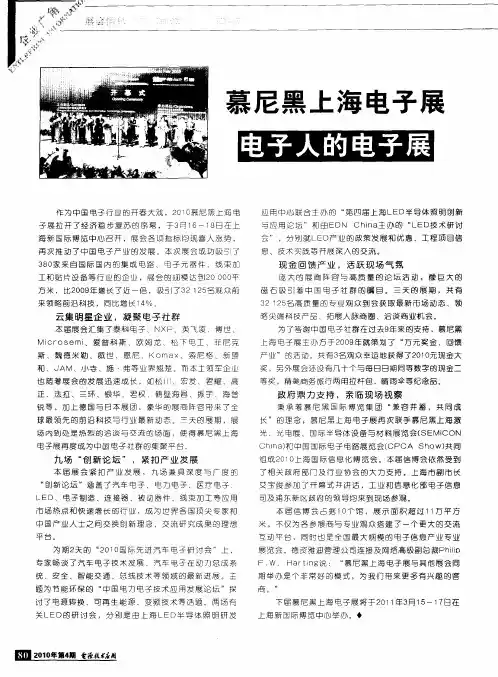
技术专栏数字印刷■ i h h h ■Labelexpo South China 2020之数?印刷技J K 篇—L -中国印刷及设备器材工业协会支持的2020华南 I I I 国际标签印刷展览会(Labelexpo South China 2020 ) 12月8 —10日在深圳国际会展中心(新馆)盛大 启幕。
为期3天的展会呈现完整的标签及包装印刷产 业链,助力中国标签印刷行业打造智慧工厂。
今年疫情的突发让企业数字化、智能化进程提前 加速,从展商结构可以看出从事数字印刷或印后加工 的企业数量明显增加,占到展商总数的40%之多,涉 及不同的数码印刷技术以及加工工艺,如:电子油墨 技术、碳粉技术、数字U V 喷墨印刷技术以及彩色喷 墨打印技术等。
下面具体介绍主要数字印刷设备供应 商带来的新产品和服务。
爱普生首款8英寸宽幅面G W -6030/C 6530系列彩色标签打印机爱普生首款8英寸宽幅面C W -6030/C 6 530系列 彩色标签打印机的幅面更宽,应用范围更广,适用于 制造、零售、化工和电力等多个行业覆盖。
其工业级 设计助力智能制造,通过将打印、剥离合二为一,可 使标签底纸自动分离,且外部设备全方位适配,提升 流水线自动化。
其1200dpi x 1200d p i 分辨率的高打印 精度、高饱和,缔造出高品质;智能补墨,支持I C C 曲线,让成品杜绝“例外”!爱普生颜料墨水通过多 种国际安全认证,印刷后的标签经久耐用,且速干、 防水、耐光和耐刮蹭。
阿诺捷A -1数码标签喷墨印刷设备阿诺捷A -1数码标签喷墨印刷设备集喷码设备与 喷码平台于一体,是一台集小字符、大字符、高解析、 条码和可变数据于一体的智能U V 喷码机,支持喷印 国际通用一维码和二维码,能满足不同可变码型要求, 软件可以提供二次开发接口,便于集成不同系统,适 合各种生产线在线或离线加装。
其主机可拓展四个独 立喷头,可喷印固定和可变数据,喷印图案清晰度高。
2021年慕尼黑上海电子生产设备展及展会论坛信息展出日期:2021-03月15-17日展馆名称:上海新国际博览中心主办单位:慕尼黑展览上海(有限)公司招商单位:广州北上广展览服务有限公司◆展会介绍:2018重要数据*观众数量2018 年77,7652017年68,2152016年61,4552015 年55,3652014年51,4982018观众:77,765名(同比增长14%)展商数量2018年1,3742017年1,2302016年1,0882015年1,0062014年8682018年展商:1,374家(同比增长12%)2018年展出面积:80,000平方米2019年展出面积:85,000平方米◆productronica China,智在创新全方位展示电子制造领域先进设备和技术从机器人、SMT表面贴装技术、电子制造自动化、运动控制、线束加工、点胶注胶,到焊接焊料、电子化工材料、EMS ,以及印刷电子,productronica China将全方位呈现引领现代电子制造业的尖端技术和应用解决方案。
多展联动,优质客户成就商机联合同期举办的慕尼黑上海电子展(electronica China),展会规模将突破85,000平方米,预计参展商数量将超过1,500家,海内外观众数量将达到85,000名。
为全行业呈现智慧电装工厂解决方案展会围绕“智”在创新的核心主题,汇聚电子制造业领军企业,将共同以全球化的创新视野、理念与技术,帮助中国电子制造企业打造从传统自动化向完全互连和柔性系统飞跃的“智慧工厂”。
高质量的组团专业观众超过300家企业以组团形式到场参观展会,涵盖了EMS、汽车电子、半导体制造、手机平板等消费电子、安防等各应用行业。
越来越多的高质量专极具前瞻性的同期活动展会期间将举办多场行业论坛、技术竞赛和机器运作演示活动,专注行业热点、邀请来自电子制造行业、应用领域以及科研院所的业界领袖、技术专家、科研学者为与会观众答疑解惑,分享生产案例,提供先进技术解决方案,展望行业未来发展趋势。
2020慕尼黑华南电子展+electronica South China|及组团参观信息
举办时间:2020-11-3-5
举办地点:深圳国际会展中心
同期举办:Vision China (深圳) 机器视觉展览会、深圳国际自动化及机器人技术展览会、慕尼黑上海电子生产设备展、华南先进激光及加工应用技术展览会
慕尼黑华南电子展(electronica South China)是继慕尼黑上海电子展(electronica China)之后,慕尼黑电子展这一品牌进入中国后第二个子品牌展会。
慕尼黑华南电子展(electronica South China)立足深圳,辐射华南地区及东南亚市场,为电子行业搭建高品质的全产业链创新展示平台,汇聚国内外知名企业,吸引行业优质买家及精英,为蓬勃发展的华南地区电子产业市场创造更多商机。
- 功率电子变换器
国际连接器创新论坛
*连接器技术趋势和发展(大电流、高密度、小型化、高频高速等)
*5G移动通讯设备连接器的创新发展和市场动态分析
*连接器技术在轨道交通、新能源汽车等领域的集成创新和应用研究
*连接器行业智能制造的创新发展
*连接器设计、材料、工艺和检测等基础共性技术的最新发展
全球物联网技术创新高峰论坛
*PCB行业和智能工厂*数字孪生的潜力*加速迈向工业4.0 *智能制造中的半导体用量变化分析*智能制造领域需要解决的基础技术课题*ASM迈向工业4.0的后端设备智慧工厂解决方案*适用于工业机器人伺服控制器的光耦及应用*AI实现工业决策自动化
国际电力电子创新论坛
电力电子新器件与电源创新技术智能电网的电源应用与关键技术新能源汽车充电控制——智能交通电气化的核心
国际智能制造生态链峰会
PCB行业和智能工厂数字孪生的潜力加速迈向工业4.0 智能制造中的半导体用量变化分析智能制造领域需要解决的基础技术课题ASM迈向工业4.0的后端设备智慧工厂解决方案适用于工业机器人伺服控制器的光耦及应用AI实现工业决策自动化
国际医疗电子创新论坛
医疗电子产业现状与发展趋势可穿戴医疗电子与健康物联网医疗人工智能
人工智能落地应用研讨会
会议议题:从技术、产业、应用等角度对人工智能技术和产业的发展现状进行深入探讨、包括脑机融合、人工智能算法、框架平台、智能芯片、大数据、智能图像、智能语音、智能驾驶IPC PCB设计技术交流会
应用机器学习技术改善内存总线多变量仿真分析方法怎样解决高速SI签核中的自动串扰扫描、阻抗扫描和DRC+难题产品失效与PCB设计之关联性PCB制造的可靠性设计及DFM案例分析DFM分析在板级设计和制造中的作用PCB工艺可靠性设计
报名热线:广州北上广展览服务有限公司
地址:广州市天河区珠村东横四路1号之1豪汇商务中心B468室
联系人:陈飞壹叁陆壹壹肆捌捌肆贰伍
组团参观报名方式
第一步:扫描左侧二维码,关注e星球服务号
第二步:填写团长信息表单
第三步:下载【团体观众报名表】
第四步:填写后回传至:Tiffany.Liu@
团体观众专享福利
电子胸卡:展前收到团队成员的参观电子胸卡,免去现场登记手续,直接入场参观?
专人接待:展会现场专人接待,免费指引及讲解,拍摄参观纪念照片
精美礼包:每位团员可获赠精美礼包一份(内含午餐券、精美礼品、参观指南等)商贸配对:提前告知参观、采购意向,可组织与展商的深度洽谈
额外新年大礼:1月24日前提交组团观众申请表并通过审核,团队将获得展会资料及新年大礼?
团长礼遇
团长等级
团员要求团长礼品
铂金团长
10-20人(至少10人同时到场参观)
尊享礼包
星钻团长
20人以上(至少20人同时到场参观)。